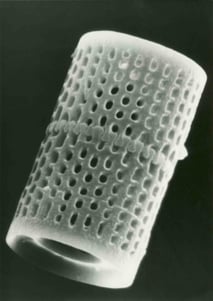 Microscopic view of a single diatom,diatomaceous earth (DE)
Microscopic view of a single diatom,diatomaceous earth (DE)
Millions of years ago, Nevada was covered by water. In those lakes, microscopic single-celled plants called diatoms, thrived. When they died, they left behind huge deposits of the fresh-water diatomaceous earth (DE). EP Minerals has mined this high-quality DE in Nevada for over 70 years, used around the world in hundreds of products and applications.
Thank you to Chris Hull, for his blog post on organicauthority.com, spreading the word about DE!
Admit it: You’ve been lured by the siren’s song of late night infomercials. You know, the ones that offer a product that promises everything from weight loss to thicker hair to increased sexual potency. Well, what if I told you that I know of a product that will truly control your garden’s pests, polish your dingy pots, and kill your dog’s fleas? Sounds too good to be true, right? It’s a real thing, and it’s called diatomaceous earth.
What is diatomaceous earth?
Diatomaceous earth (DE) is a white powder that’s similar in texture to talc. It’s made up of tiny fossilized aquatic phytoplankton called diatoms. These diatoms have skeletons that are made of silica. It is this silica that is useful. Over the ages, these diatoms with their silica-rich skeletons, have accumulated in river beds, streams, oceans, and lakes. Today silica is mined from these wet areas.
How does DE work?
Diatomaceous earth is very hard–almost as hard as a diamond. When it is broken up it has (very tiny) sharp edges. It’s these sharp edges that give it its power.
In the garden and in the home these sharp edges tear away at the exoskeletons of insects, like fleas. Kind of like a scene from a horror movie, DE destroys the exoskeletons leaving a goopy puddle of bug guts. (Thankfully, DE doesn’t have the same effect on mammals.)
In the garden…
Diatomaceous Earth is a valuable tool for organic gardeners.
It is a method of pest control that is not harmful to humans or pets. However, DE will kill aphids, thrips, mites, ants, flea beetles, cockroaches, snails, slugs, and other garden pests with exoskeletons. It will not harm beneficial critters such as worms.
Gardeners who use chemical pesticides in their gardens find that over time the pests develop a natural resistance to the pesticide. Thus, these gardeners have to use more and more nasty chemicals to be effective, and a dangerous cycle of poisoning the earth begins. DE does not have this effect because pests can not develop a resistance to it (kind of like us with bullets).
Love your compost bin but hate its odor? Sprinkle DE in the bin and eradicate that odor. Also, if pests such as June bug beetles and earwigs are plaguing your compost bin, an application of DE will kill them but leave your compost unharmed.
Have you harvested more potatoes, or other storage crop, than you can eat? Sprinkle the spuds with DE before you store them and it will act as a natural food preservative.
Although DE is lethal to bees, beekeepers use careful applications to control ants around their hives.
A couple notes:
In order for DE to kill bugs, it must be kept dry. Even a light morning dew may render it ineffective.
Also, how much DE you should use is subjective. I’ve never encountered any hard-and-fast rules for how much to use. Trial and error will be your best guide. For example, if you sprinkle it on your garden to get rid of slugs but they reappear in a few days, then use another application.
Around the home…
Diatomaceous earth is an all natural cleaning agent. Do you have pots and pans in your kitchen with stubborn stains? Try scrubbing them with DE for shining results. The same is true for your toilet bowl.
Are bed bugs a problem? Sprinkle DE under and around your mattress to eradicate the pests. Is your trash especially stinky? Sprinkle it with DE to absorb odor.
Other uses…
DE has numerous other uses as well. It can be used as a deodorant, toothpaste, facial scrub, and shoe deodorizer. Add it to your cat’s kitty litter and it will help to absorb odors and moisture.
Learn more about EP Minerals DE products here: https//epminerals.com/DE products.
